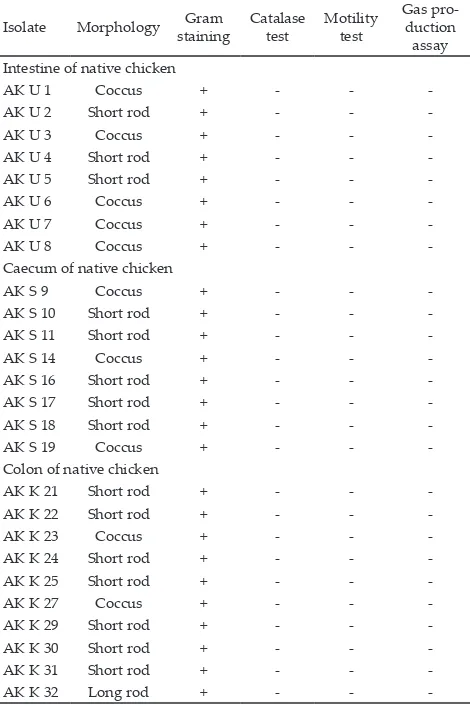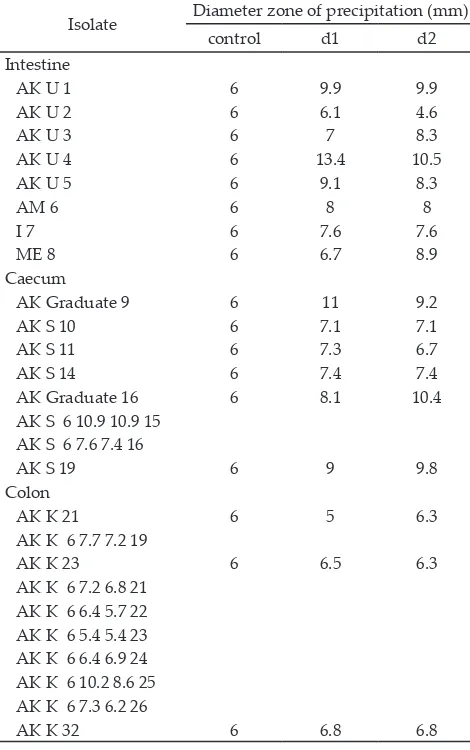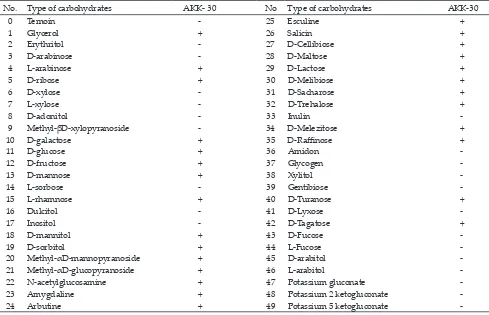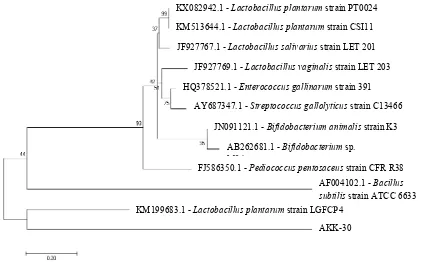*Corresponding author: E-mail: [email protected]
Strengthening No: 36b/E/KPT/2016 Available online at htp://medpet.journal.ipb.ac.id/
Isolation of Lactic Acid Bacteria with Cholesterol-Lowering Activity from Digestive
Tracts of Indonesian Native Chickens
H. Julendraa, A. E. Suryania*, L. Istiqomaha, E. Damayantia, M. Anwara, & N. Fitrianib aResearch Center for Natural Product Technology (BPTBA), Indonesian Institute of Sciences (LIPI)
Gading, Playen, Gunungkidul DI. Yogyakarta, Indonesia
bStudent of Department of Biology, Faculty of Mathematics and Natural Sciences, Sebelas Maret University (UNS) Jalan Ir. Sutami No. 36A, Jebres, Kota Surakarta, Jawa Tengah 57126, Indonesia
(Received 29-09-2016; Reviewed 24-11-2016; Accepted 06-03-2017)
ABSTRACT
The aim of the study was to identify the cholesterol-lowering activity of indigenous lactic acid bacteria isolated from the small intestine, cecum, and colon of Indonesian native chickens and evalu-ated for bile salt hydrolase (BSH) activity in vitro by using MRS media added taurodeoxycholic acid (TDCA) and CaCl2. The quantitative measurement of cholesterol-lowering activity of LAB was inves-tigated by using soluble cholesterol containing MRS broth (100 µg/mL of cholesterin) and incubated at 37 °C for 48 h. Cholesterol content in supernatant was analyzed using microplate reader. The high-est percentage of cholhigh-esterol reduction found in isolates from colon of native chicken with the value
of 17.43% and identiied as Lactobacillus plantarum. Based on phylogenetic tree analysis, this isolate was closely related to L. plantarum strain LGFCP4 (accession number KM199683.1) isolated from GIT of Guinea fowl from India. It could be concluded that L. plantarum AKK-30 had cholesterol-lowering activity.
Keywords: lactic acid bacteria (LAB), cholesterol, bile salt hydrolase (BSH), native chicken
ABSTRAK
Penelitian ini bertujuan untuk mengidentiikasi aktivitas penurunan kolesterol oleh bakteri
asam laktat indigenous. Bakteri asam laktat (BAL) diisolasi dari usus halus, sekum dan kolon ayam kampung Indonesia dan dievaluasi terhadap aktivitas hidrolase garam empedu secara in vitro dengan menggunakan media MRS yang ditambahkan asam taurodeoxycholic (TDCA) dan CaCl2. Pengukuran secara kuantitatif aktivitas penurunan kolesterol oleh BAL dilakukan dengan menggu-nakan MRS Broth yang mengandung kolesterol terlarut (100 µg/mL cholesterin) dan diinkubasikan pada suhu 37 oC selama 48 jam. Kolesterol yang terkandung di dalam supernatan dianalisis meng-gunakan microplate reader. Persentase penurunan kolesterol tertinggi dengan nilai 17.43% ditemukan
pada isolat yang berasal dari kolon ayam kampung dan diidentiikasi sebagai Lactobacillus plantarum.
Berdasarkan analisis pohon ilogeni, isolat tersebut memiliki kekerabatan yang dekat dengan L. plan-tarum strain LGFCP4 (accession number KM199683.1) yang diisolasi dari saluran pencernaan ayam mutiara asal India. Dapat disimpulkan bahwa L. plantarum AKK-30 memiliki aktivitas menurunkan kolesterol.
Kata kunci: bakteri asam laktat (BAL), kolesterol, hidrolase garam empedu, ayam kampung
INTRODUCTION
Cholesterol contained in broiler meat without skin is around 133-202 mg/100 g of dry mater (DM) basis and in the whole meat is around 261-407 mg/100 g of DM (Ismoyowati & Widyastuti, 2003). Native chicken
Bile-salt hydrolase (BSH) are enzyme deconjugates bile acid into glycine or taurine from the steroid moi-ety, producing free bile salts. Deconjugated bile salt is not easy to be absorbed by small intestine then it is excreted in feces that eventually reduces the number of bile acids returned to the liver. BSH activity is detected in some strains related to the gastrointestinal tract (GIT), representing several species of LAB (Biidobacterium and Lactobacillus) indigenous of the digestive tract (Kumar et al., 2012). However, probiotics derived from endogenous bacteria of chicken is still ineicient. Probiotics that do not originate from the indigenous bacteria when enter-ing through the digestive tract will be damaged before it reaches the small intestine, therefore the use of probiotic from indigenous bacteria are expected to be more toler-ant to change in pH, temperature, and enzyme activity of digestive tracts.
Based on research conducted by Agaliya & Jeevaratnam (2012) studying cholesterol lowering efect of 8 lactobacilli, the strain L. plantarum JJ18 showed a higher cholesterol removal capacity from media and tolerance towards acid and bile. Cenesiz et al. (2008) also reported that supplementation of LAB as probiotic in broiler birds signiicantly (P≤0.05) reduced total choles-terol serum level.
The aim of the study was to identify the cholester-ol-lowering activity of indigenous lactic acid bacteria isolated from the small intestine, cecum, and colon of Indonesian native chickens and evaluated for bile salt hydrolase (BSH) activity in vitro by using MRS media added taurodeoxycholic acid (TDCA) and CaCl2. This LAB will be used for chicken as a feed additive to re-duce the cholesterol level in poultry meat.
MATERIALS AND METHODS
Isolation and Identiication of Lactic Acid Bacteria
Strains of LAB were collected from digestive tract of Indonesian native chicken (Ayam Kampung) accord-ing to Torshizi et al. (2008) method. Small intestine, cecum, and colon were cut, and the contents of lumen were taken and then diluted in NaCl solution (Merck) 0.85% up to 105 dilutions. de Mann Rogosa Sharpe (MRS) Agar media (Oxoid) with pH 6.2 and 0.2% CaCO3 (Merck) was plated and incubated at 37 °C for 24 h with the addition of each serial dilution. The LAB colonies were identiied by clearing zone appearance. LAB characterization procedures consisted of morphol-ogy, Gram staining, catalase, gas production, and motil-ity tests according to Krieg et al. (2010). API 50 CHL kit (bioMērieux) were used to observe biochemical identi-ication of the selected LAB. The observation data were determined by API web software (bioMērieux).
The identiication of LAB was also conirmed using alignment of 16S rRNA gene sequence avail-able in GenBank. DNA genome from LAB was isolated according to PeqGOLD Bacterial DNA kit. DNA was ampliied using primer sequences of 27f
(5’-AGAGTTTGATCCTGGCTCAG-3’) and 1492r
(5’-GGTTACCTTGTTACGACTT-3’) (Gong et al., 2007). Sequencing of 16S rRNA gene was conducted
by First BASE laboratories (Singapore). Data of DNA sequence was edited by FinchTV program and contiq with BioEdit, and kept in FASTA format. The sequence result was analyzed by basic local alignment search tool (BLAST) program by accessing data in NCBI. Phylogenetic analysis was performed by comparing several sequences with high similarity in BLAST result. Statistical method was using Maximum-likelihood. Stability of grouping was measured using 1000 boot-strap replicates. Phylogenetic tree was performed by MEGA5 program (Cobos et al., 2011).
LAB isolates were kept at −80 °C in MRS broth consisting of 15% (v/v) glycerol. An MRS-agar plate was streaked from the frozen stock to ensure purity for any assay.
Bile Salt Hydrolase Activity
Prior to determining the ability of LAB in lowering of cholesterol, the selected isolates were tested to make sure whether they have bile salt hydrolase (BSH) activ-ity. The test was conducted by impregnation around sterilized paper disks (Oxoid) on the MRS agar plates added with sodium salt of taurodeoxycholic acid 0.5% (w/v) (TDCA, Sigma, USA), and 0.37 g/L CaCl2 (Merck). Plates were incubated in anaerobic condition for 72 h at 37 °C, and the precipitation zones diameter around the disks was calculated (Lim et al., 2004; Sirilun et al., 2010).
Cholesterol-lowering Activity
Cholesterol lowering efect= (C–C’)/C,
where the concentrations of cholesterol existing in the supernatants of uninoculated and inoculated were C and C’ (Guo et al., 2011). Cholesterol-lowering percent-age by each Lactobacillus strain was also calculated as follow:
% Cholesterol-lowering= [(cholesterol-lowering (µg/ mL)/cholesterol (µg/mL)] × 100%
RESULTS
Isolation of Lactic Acid Bacteria Candidates from Chicken’s Gastrointestinal Tract
Lactic acid bacteria isolation from chicken’s di-gestive tract was successful in selecting 26 (8 isolates derived from the small intestine, eight isolates from the cecum, and ten isolates from the colon). The selected LAB had a single colony, and clear zone appearance on MRS-agar supplemented with 0.2% CaCO3. These isolates did not have catalase, did not produce gas on Glucose Yeast Peptone (GYP) medium, non-motile on Sucrose Yeast Peptone (SYP) medium, Gram-positive and had coccus and rod shape.
Characterization of Selected Lactic Acid Bacteria
Table 1 showed that 26 isolates characterized as LAB produced negative results on catalase test. Observations of 26 isolates of LAB by staining showed that all isolates were Gram-positive (Damayanti et al., 2012). Motility test indicated that all of isolates had non-motile properties showing no movement that resembles a vine-propagation besides the needle puncture area and there was no cloud formation at SYP medium.
Bile Salt Hydrolase Activity
For 26 isolates tested, all have the precipitation zones (Figure 1) with diferent diameters (Table 2). Isolates with the largest diameter values were isolated from chicken intestine (AKU-4), while isolates that have the smallest diameter values were isolated from chicken colon (AKK-21).
In vitro Test for Cholesterol-lowering Activity
The results showed that the ten isolates of LAB have the action for lowering cholesterol levels (Table 3). The activity of LAB to decrease cholesterol varied in a range of 16.6-34.4 µg/mL. The highest activity was shown by AKK-30 with percentage of 17.43% followed by AKU-4 at 15.24%, and AKS-16 at 15.02%, while the lowest cholesterol reduction rate present in isolates AKS-19 with 8.41% compared to control.
Identiication of Selected LAB with the Highest
Cholesterol-lowering Activity
The chosen lab isolate was identiied based on bio-chemical procedures by using API 50 CHL kit
(bioMer-ieux) as shown in Table 4. In biochemical identiication, AKK-30 isolate was identiied as Lactobacillus plantarum (92.3% of similarity), and 27 types of carbohydrates were able to be fermented. Based on 16s rRNA sequenc-es analysis, AKK-30 was identiied as L. plantarum.
Note: (-)= Negative reaction, (+)= Positive reaction. Isolate Morphology Gram
staining
Catalase test
Motility test
Gas pro-duction assay Intestine of native chicken
AK U 1 Coccus + - -
-AK U 2 Short rod + - -
-AK U 3 Coccus + - -
-AK U 4 Short rod + - -
-AK U 5 Short rod + - -
-AK U 6 Coccus + - -
-AK U 7 Coccus + - -
-AK U 8 Coccus + - -
-Caecum of native chicken
AK S 9 Coccus + - -
-AK S 10 Short rod + - -
-AK S 11 Short rod + - -
-AK S 14 Coccus + - -
-AK S 16 Short rod + - -
-AK S 17 Short rod + - -
-AK S 18 Short rod + - -
-AK S 19 Coccus + - -
-Colon of native chicken
AK K 21 Short rod + - -
-AK K 22 Short rod + - -
-AK K 23 Coccus + - -
-AK K 24 Short rod + - -
-AK K 25 Short rod + - -
-AK K 27 Coccus + - -
-AK K 29 Short rod + - -
-AK K 30 Short rod + - -
-AK K 31 Short rod + - -
-AK K 32 Long rod + - -
-Tabel 1. Characteristics of lactic acid bacteria isolated from di-gestive tracts of native chicken
Table 2. Diameter precipitation zone of 26 isolates lactic acid bacteria from digestive tracts of native chicken
Isolate Diameter zone of precipitation (mm)
control d1 d2
AK Graduate 16 6 8.1 10.4
AK S 6 10.9 10.9 15
Isolation of Lactic Acid Bacteria Candidates from Chicken’s Gastrointestinal Tract
Supplementation of CaCO3 into the media was intended to obtain early estimation colonies of LAB with the clear zone presence appeared after the incubation period. Calcium carbonate reacted with the lactic acid produced by LAB thus forming Ca-lactate acids and identiied by clear zone around the colonies on media (Harimurti et al., 2005). According to Jannah et al. (2014), microbiota diversity and abundance varied at a particu-lar location along the gastrointestinal tract, the number of the microbiota declined in less favorable condition
Table 3. Cholesterol value from in vitro test using ELISA Microplate Reader (ppb)
AK U 1 AK U 4 AK U 5 AK U 6 AK U 8 AK S 9 AK S 16 AKS 17 AK S 19 AK K 30 CONTROL
183.8 171.2 166.4 185.0 179.0 175.7 169.6 162.5 198.1 166.2 207.8
175.1 168.9 185.3 170.4 178.8 180.7 164.2 170.2 173.3 164.0 194.0
177.6 161.7 174.2 170.6 170.4 173.6 169.3 173.2 170.8 158.6 190.2
for bacterial growth. The presence of microorganisms in the poultry’s digestive tract due to the interaction of bacteria with the environment that entry by feeding. Diferences age of the chicken also gave diferences in the amount and type of bacteria present in the gastro-intestinal tract. Heravi et al. (2011) also stated that the bacteria isolated from chicken digestive was Lactobacillus which had speciication such as positive Gram stain, catalase negative reactions, and form of bacillus and the ampliication of 16s rRNA fragments (0.24 kbp) using speciic primers assured that all isolated bacteria belongs to the genus of Lactobacillus.
Characterization of Selected Lactic Acid Bacteria
Negative results on catalase test that were found in 26 isolates indicated by the formation of oxygen after H2O2 addition. This lead to accordance with Adams & Nout (2001) who stated that LAB had negative catalase activity. The gas production assay from all isolates showed negative result hence the isolates were homo-fermentative (Shazali et al., 2014). Based on biochemical point of view, LAB consist of both homofermenters, yielding mainly lactic acid, and heterofermenters, which, apart from lactic acid, produce a large variety of fermentation metabolites such as acetic acid, carbon dioxide, ethanol, and formic acid (Kleerebezem & Hugenholz, 2003).
In this research 26 isolates of LAB included in the class of gram-positive bacteria when it formed purple color under a microscope. Negative results from motility test showed that the lactic acid bacteria had no lagella for movement.
Bile Salt Hydrolase activity
In Vitro Test for Cholesterol-lowering Activity
Top ten isolates with the highest precipitation zone diameters were determined for cholesterol-lowering activity. The cholesterol-lowering test of the isolates was investigated upon incubation with 100 µg/mL water-soluble cholesterol-Tween 80 in MRS. Compared to the results of BSH enzyme activity, the higher precipitation zone providing opportunities to the higher cholesterol reduction activity, but it was not always linear with the results from this study. Isolates with the greatest pre-cipitation zone (AKU-4) did not show the highest activ-ity in the cholesterol-lowering test, while AKK-30 which had smaller precipitation zone than AKU-4 produced the highest cholesterol-lowering activity. This discrep-ancy might be due to diferent cholesterol-lowering mechanisms in each test.
There are several mechanisms of LAB in lower-ing cholesterol. LAB will produce the BSH enzyme which played a role as an anti-cholesterol. BSH enzyme catalyzed a reaction in which glycine and taurine were deconjugated from bile salts. The corresponding un-conjugated bile acids precipitate at low pH, which can not be reabsorbed by liver in the cycle of enterohepatic (Seeley et al., 2000) so it is excreted in the feces, resulting in reduced cholesterol levels (Huang et al., 2013).
Identiication of Selected LAB with the Highest
Cholesterol-Lowering Activity
The selected LAB isolate was identiied based on biochemical procedures by using API 50 CHL kit (bioMerieux) as shown in Table 4. In biochemical iden-tiication, AKK-30 isolate was identiied as L. plantarum (92.3% of similarity), and 27 types of carbohydrates were able to be fermented.
Characterization of LAB was based on 16S rRNA sequences analysis to determine the genus and strain. This gene was ampliied using universal primer 27f and 1492r, and the ampliication result was shown in Figure 2. PCR product of 16S rRNA gene was 1500 bp.
BLAST homology of 16S rRNA sequences in NCBI site revealed that AKK-30 isolate was identiied as L. plantarum with a length of 1414 bp in DNA bank database (NCBI) had 100% of max identity, 2612 of the max score, 2612 of the total score, 100% of query coverage, and 0.0 of E-value. The bacteria were clas-siied in Kingdom of Bacteria, Division of Firmicutes, Class of Bacilli, Order of Lactobacillales, Family of Lactobacillaceae, Genus of Lactobacillus, and Species of L. plantarum. According to Stackebrandt & Ebers (2006), when the similarity percentage of 16S rRNA gene se-quence between 2 organism was less than 98.7%-99.0%, then both of them was diferent species.
Table 4. Fermentation of 49 types of carbohydrate based test identiication using API KIT 50 CHL for AKK-30
No. Type of carbohydrates AKK- 30 No Type of carbohydrates AKK-30
0 Temoin - 25 Esculine +
1 Glycerol + 26 Salicin +
2 Erythritol - 27 D-Cellibiose +
3 D-arabinose - 28 D-Maltose +
4 L-arabinose + 29 D-Lactose +
5 D-ribose + 30 D-Melibiose +
6 D-xylose - 31 D-Sacharose +
7 L-xylose - 32 D-Trehalose +
8 D-adonitol - 33 Inulin
-9 Methyl-βD-xylopyranoside - 34 D-Melezitose +
10 D-galactose + 35 D-Rainose +
11 D-glucose + 36 Amidon
-12 D-fructose + 37 Glycogen
-13 D-mannose + 38 Xylitol
-14 L-sorbose - 39 Gentibiose
-15 L-rhamnose + 40 D-Turanose +
16 Dulcitol - 41 D-Lyxose
-17 Inositol - 42 D-Tagatose +
18 D-mannitol + 43 D-Fucose
-19 D-sorbitol + 44 L-Fucose
-20 Methyl-αD-mannopyranoside + 45 D-arabitol
-21 Methyl-αD-glucopyranoside + 46 L-arabitol
-22 N-acetylglucosamine + 47 Potassium gluconate
-23 Amygdaline + 48 Potassium 2 ketogluconate
-24 Arbutine + 49 Potassium 5 ketogluconate
Figure 3. Phylogenetic tree of AKK-30 isolate and bacteria in the chicken’s GIT constructed by a neighbor-joining method. The scale bar represents a sequence divergence of 5%.
Figure 2. PCR Product 16S rRNA of AKK-30 isolate and DNA ladder (1 kb DNA ladder)
A 1
500 bp
250 bp 750 bp 1000 bp 1500 bp 2000 bp 10000 bp
1 kb AKK-30
Amplicon 16S rRNA
KM513644.1 - Lactobacillus plantarum strain CSI11 KX082942.1 - Lactobacillus plantarum strain PT0024
JF927769.1 - Lactobacillus vaginalis strain LET 203 JF927767.1 - Lactobacillus salivarius strain LET 201
HQ378521.1 - Enterococcus gallinarum strain 391
AY687347.1 - Streptococcus gallolyticus strain C13466
JN091121.1 - Bifidobacterium animalis strain K3
AB262681.1 - Bifidobacterium sp. M24
FJ586350.1 - Pediococcus pentosaceus strain CFR R38
KM199683.1 - Lactobacillus plantarum strain LGFCP4
AF004102.1 - Bacillus subtilis strain ATCC 6633
AKK-30 Phylogenetic analysis of AKK-30 isolate by
nucleo-tide reference from Gen Bank data in NCBI was shown in Figure 3. Branch lengths are proportional to genetic distances (Becher et al., 1997). Bootstrap values of over 70% is shown for 1,000 replicate datasets (Coenye & Vandamme, 2003). The tree describes the relationship between selected sequences retrieved from the GenBank database and nucleotide sequences in this study. The phylogenetic tree showed that L. plantarum AKK-30 isolated from Indonesian native chicken was closely
related to L. plantarum strain LGFCP4 isolated from GIT of Guinea fowl from India. Gong et al. (2007) stated that microbial ecology of chicken intestinal, as well as the diversity, phylogeny, distribution, and success of the bacteria as well as bird age, diet, and managing of dietary antibiotics afect the microbiota composition in these two GI tract regions. The complexity and diversity of the community structure of cecal bacteria were much higher than that of reported by culture-based studies. Moreover, a signiicant number of 16S rRNA genes isolated from cecal microbiota were also found to be related to uncultured bacteria identiied in human feces and the intestine of other animals (including ruminants, pigs, and mice).
CONCLUSION
REFERENCES
Adams, M. R. & R. Nout. 2001. Fermentation and food safety. Aspen Publishers, Washington DC.
Agaliya, P. J. & K. Jeevaratnam. 2012. Screening of Lactobacillus plantarum isolated from fermented idli for probiotics properties. Afr. J. Biotechnol. 11: 12856-12864.
Becher, P., M. Orlich, A. D. Shannon, G. Horner, M. KÖnig, & H. J. Thiel. 1997. Phylogenetic analysis of pestiviruses from domestic and wild ruminants. J. General Virol. 78: 1357-1366. htps://doi.org/10.1099/0022-1317-78-6-1357
Cenesiz, S., H. Yaman, A. Ozcan, & G. Karademr. 2008. Efect of keir as probiotic on serum cholesterol, total lipid, aspartate amino transferase and alanina amino transferase activities in broiler chicks. Med. Weter. 64:168-170.
Cobos, M. A., A. L. de Coss, N. D. Ramirez, S. S. Gonzales, & R. F. Cerrato. 2011. Pediococcus acidilactici isolated from the rumen of lambs with rumen acidosis, 16S rRNA iden-tiication and sensibility to monensian and lasalocid. Res. Vet. Si. 90: 26-30. htps://doi.org/10.1016/j.rvsc.2010.05.006
Coenye, T. & P. Vandamme. 2003. Extracting phylogenetic in-formation from whole-genome sequencing projects: the lactic acid bacteria as a test case. Microbiology 149: 3507-3517. htps://doi.org/10.1099/mic.0.26515-0
Damayanti, E., H. Herdian, M. Angwar, A. Febrisiantosa & L. Istiqomah. 2012. Lactic acid bacterial screening from gastrointestinal digestive tract of native broiler chicken for probiotic candidate purposes. J. Indonesian Trop. Anim. Agric. 37: 168-175. htps://doi.org/10.14710/ jitaa.37.3.168-175
de Ross, N. M. & M. B. Katan. 2000. Efect of probiotic bacteria on diarhea, lipid metabolism, and carcinogenesis: A re-view of paper published between 1988 and 1998. American Journal of Clinical Nutrition. 71: 405-411.
Guo, L-D., L-.J Yang, & G-C. Huo. 2011. Cholesterol removal by Lactobacillus plantarum isolated from homemade fer-mented cream in inner Mongolia of China. Czech J. Food Sci. 29: 219-225.
Gong, J., W. Si, R. J. Foster, R. Huang, H. Yu, Y. Yin, C. Yang, & Y. Han. 2007. 16S rRNA Gene-based analysis of mucosa-associated bacterial community and phylog-eny in the chicken gastrointestinal tracts: from crops to ceca. FEMS Microbiol. Ecol. 59: 147-157. htps://doi. org/10.1111/j.1574-6941.2006.00193.x
Harimurti, S., E. S. Rahayu, Nasroedin, & Kurniasih. 2005. Bakteri asam laktat dari intestin ayam sebagai agensia pro-biotik. Anim. Prod. 9: 82-91.
Heravi, R. M., H. Kermanshahi, M. Sankian, M. R. Nassiri, A. H. Moussavi, L. R. Nasiraii, & A. R. Varasteh. 2011. Screening of lactobacilli bacteria isolated from gastroin-testinal tract of broiler chickens for their use as probiotic. African J. Microbiol. Res. 5: 1858-1868.
Huang, Y., X. Wang, J. Wang, F. Wu, Y. Sui, L. Yang, & Z. Wang.
2013. Lactobacillus plantarum strains as potential probiotic cultures with cholesterol-lowering activity. J. Dairy Sci. 96: 2746-2753. htps://doi.org/10.3168/jds.2012-6123
Ismoyowati, I. & T. Widiyastuti. 2003. Fat and cholesterol content of breast and thigh meat of local fowls. J. Animal Production 5: 79-82.
Jannah, S. N.,A.Dinoto, K. G. Wiryawan, & I. Rusmana. 2014. Characteristics of lactic acid bacteria isolated from gastro-intestinal tract of cemani chicken and their potential use as probiotics. Med. Pet. 37:182-189. htps://doi.org/10.5398/ medpet.2014.37.3.182
Kleerebezem, M. & J. Hugenholz. 2003. Metabolic pathway engineering in lactic acid bacteria. Curr. Opin. Biotechnol. 14:232–237. htps://doi.org/10.1016/S0958-1669(03)00033-8
Krieg, N. R., J. T. Staley, D. R. Brown, B. P. Hedlund, B. J. Paster, N. L. Ward, W. Ludwig, & W. B. Whitman. 2010. Bergey’s Manual of Systematic Bacteriology. 2nd Ed. Springer, USA. Kumar, M., R. Nagpal, R. Kumar, R. Hemalatha, V. Verma,
A. Kumar, C. Chakraborty, B. Singh, F. Marota, S.
Jain, & H. Yadav. 2012. Cholesterol-lowering probiot-ics as potential biotherapeutprobiot-ics for metabolic diseases. Experimental Diabetes Research. Vol. 2012: 1-14. htps:// doi.org/10.1155/2012/902917
Lim, H. J., S. Y. Kim, & W. K. Lee. 2004. Isolation of lactic acid bacteria from human intestine for probiotic use. J. Vet. Sci. 5: 391-395.
Ooi, L. G. & M. T. Liong. 2010. Cholesterol-lowering efects of probiotics and prebiotics: a review of in vivo and in vitro indings. Int. J. Mol. Sci. 11: 2499-2522. htps://doi. org/10.3390/ijms11062499
Seeley, R. R., D. S. Trent, & T. Philip. 2000. Anatomy and Physiology. 7thed. McGraw-Hill Co, New York.
Shazali N., H. L. Foo, T. C. Loh, D. W. Choe, & R. A. Rahim.
2014. Prevalence of antibiotic resistance in lactic acid bacte-ria isolated from the faeces of broiler chicken in Malaysia. Gut Pathogens 6: 1-7. htps://doi.org/10.1186/1757-4749-6-1
Sirilun, S., C. Chaiyasut, D. Kantachote, & P. Luxananil.
2010. Characterisation of non human origin probiotic Lactobacillus plantarum with cholesterol-lowering property. African J. Microbiol. Res. 14: 994-1000.
Stackebrandt, E. & Ebers. 2006. Taxonomic parameters revis-ited: “Tarnished Gold Standars”. Microbiol. Today 33: 152-155.
Tomaro-Duchesneau C., M. L. Jones, D. Shah, P. Jain, A. Saha, & S. Prakash. 2014. Cholesterol assimilation by Lactobacillus probiotic bacteria: an in vitro investigation. BioMed Res. Int. Article ID 380316, 9 pages.



